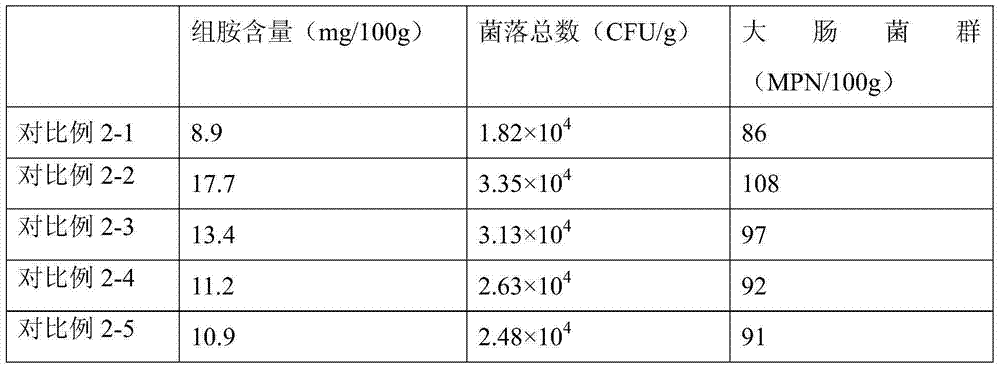Method for processing low-histamine frozen sea fish fillets
A processing method and fish fillet technology, which can be applied in fish processing, slaughtering, food science, etc., and can solve the problem of high histamine content
- Summary
- Abstract
- Description
- Claims
- Application Information
AI Technical Summary
Problems solved by technology
Method used
Image
Examples
Embodiment 1
[0054] Embodiment 1: the processing of a kind of low-histamine frozen mackerel fillet, carries out following steps successively:
[0055] 1), selection:
[0056] The captured mackerel generally has a body length of 30-40cm and a weight of 150-400g. Fresh and complete fish are selected as raw fish.
[0057] 2), classification:
[0058] Raw fish are classified according to the specifications of ≤100-200g, <200-300g, and <300-500g.
[0059] 3), 3 go:
[0060] In a processing environment at 12°C, the graded raw fish is quickly decapitated, finned, disemboweled and gutted to obtain rough processed raw fish;
[0061] The above-mentioned head removal, fin removal, belly dissection and viscera removal must be completed within 15 minutes.
[0062] 4) Immediately wash the rough-processed raw fish obtained in step 3) for the first time:
[0063] Add sodium dehydroacetate and sodium citrate to ice water at 0-4°C (prepared by adding crushed ice to clean water) to obtain cleaning solut...
Embodiment 2
[0085] Embodiment 2, a kind of processing method of low-histamine frozen mackerel fillet, carries out following steps successively:
[0086] 1), selection:
[0087]The blue-spotted Spanish mackerel grows rapidly. The body length of juvenile fish can reach 25-30cm in the current year, and the average body length of 1-2 year old fish is 50cm, and the average weight is about 800g. Select fresh and complete fish as raw fish.
[0088] 2), classification:
[0089] Raw fish are graded according to the specifications of ≤300-500g, <500-750g, <750-1000g, and <1000-1500g.
[0090] 3), 3 go:
[0091] In a processing environment at 12°C, the graded raw fish is decapitated, finned, disemboweled and gutted to obtain rough processed raw fish;
[0092] The above-mentioned head removal, fin removal, belly dissection and viscera removal must be completed within 15 minutes.
[0093] 4) Immediately wash the rough-processed raw fish obtained in step 3) for the first time:
[0094] Add sodium...
Embodiment 3
[0126] Embodiment 3, the processing of a kind of low-histamine frozen bonito flakes, carry out following steps successively:
[0127] 1), selection:
[0128] Select fresh and complete bonito as raw material fish.
[0129] 2), classification:
[0130] Raw fish are classified according to the specifications of ≤100-200g, <200-300g, <300-500g, <500-750g, and <750-1000g.
[0131] 3), 3 go:
[0132] In a processing environment at 12°C, the graded raw fish is decapitated, finned, disemboweled and gutted to obtain rough processed raw fish;
[0133] The above-mentioned head removal, fin removal, belly dissection and viscera removal must be completed within 15 minutes.
[0134] 4) Immediately wash the rough-processed raw fish obtained in step 3) for the first time:
[0135] Add sodium dehydroacetate and sodium citrate to ice water at 0-4°C to obtain cleaning solution I; the mass concentration of sodium dehydroacetate in the cleaning solution I is 1%, and the mass concentration of ...
PUM
| Property | Measurement | Unit |
|---|---|---|
| Average weight | aaaaa | aaaaa |
Abstract
Description
Claims
Application Information
 Login to View More
Login to View More - R&D
- Intellectual Property
- Life Sciences
- Materials
- Tech Scout
- Unparalleled Data Quality
- Higher Quality Content
- 60% Fewer Hallucinations
Browse by: Latest US Patents, China's latest patents, Technical Efficacy Thesaurus, Application Domain, Technology Topic, Popular Technical Reports.
© 2025 PatSnap. All rights reserved.Legal|Privacy policy|Modern Slavery Act Transparency Statement|Sitemap|About US| Contact US: help@patsnap.com


